Physical Address
304 North Cardinal St.
Dorchester Center, MA 02124
The author wishes to acknowledge the contributions of Charles E. Johnston and Megan Young for their work in the previous edition version of this chapter.
Disorders of the knee presenting in infancy include hyperextension and flexion deformities. With the exception of patellar dislocation, which may not be apparent at birth, these deformities are usually obvious in the newborn infant. When present, these disorders should trigger a thorough assessment for an associated syndromic diagnosis. Once assessment is complete and the global developmental prognosis defined, rational treatment can produce functional ambulation in children with these dramatic congenital abnormalities.
Few musculoskeletal birth abnormalities are as dramatic as congenital hyperextension of the knee ( Fig. 18.1 ). Those unfamiliar with the condition may describe the extremity as having “the knee on backward.” Clinically, the foot usually presents at the infant’s mouth or shoulder and the femoral condyles may be palpable on the distal thigh. The hyperflexion of the hip is present in utero and should raise the suspicion of concomitant hip dislocation. The incidence of congenital hyperextension deformity is less than 1 per 1000. It has been diagnosed prenatally by ultrasonography.

Congenital hyperextension deformities of the knee can be classified as congenital hyperextension, subluxation, or dislocation of the knee based on physical examination and radiographic assessment. , The degree of passive flexion of the knee also helps to determine prognosis and treatment. If the knee will flex and reduce with gentle stretching of the quadriceps, it is classified as grade 1, or congenital hyperextension of the knee (see Fig. 18.1 ). In grade 2, or congenital subluxation of the knee, the knee will not flex beyond neutral, but the femoral and tibial epiphyses are in contact and do not subluxate when flexion is attempted ( Fig. 18.2 ). If knee flexion is not possible and the tibia, which is anteriorly translated in the resting position, displaces laterally on the femur when more vigorous flexion is attempted, the deformity is classified as grade 3, or true irreducible congenital dislocation of the knee (CDK). True CDK is always associated with significant quadriceps fibrosis and shortening. Some consider this the main cause of the deformity. , , , , A true lateral radiograph of the knee may help to differentiate between knee hyperextension, subluxation, and dislocation. Fluoroscopy—or even arthrography—may not only increase the quality of the “lateral” radiograph (which may be difficult to obtain because of the deformity, and patient age and size) but allows dynamic assessment of the femoral–tibial relationship ( Fig. 18.3 ).
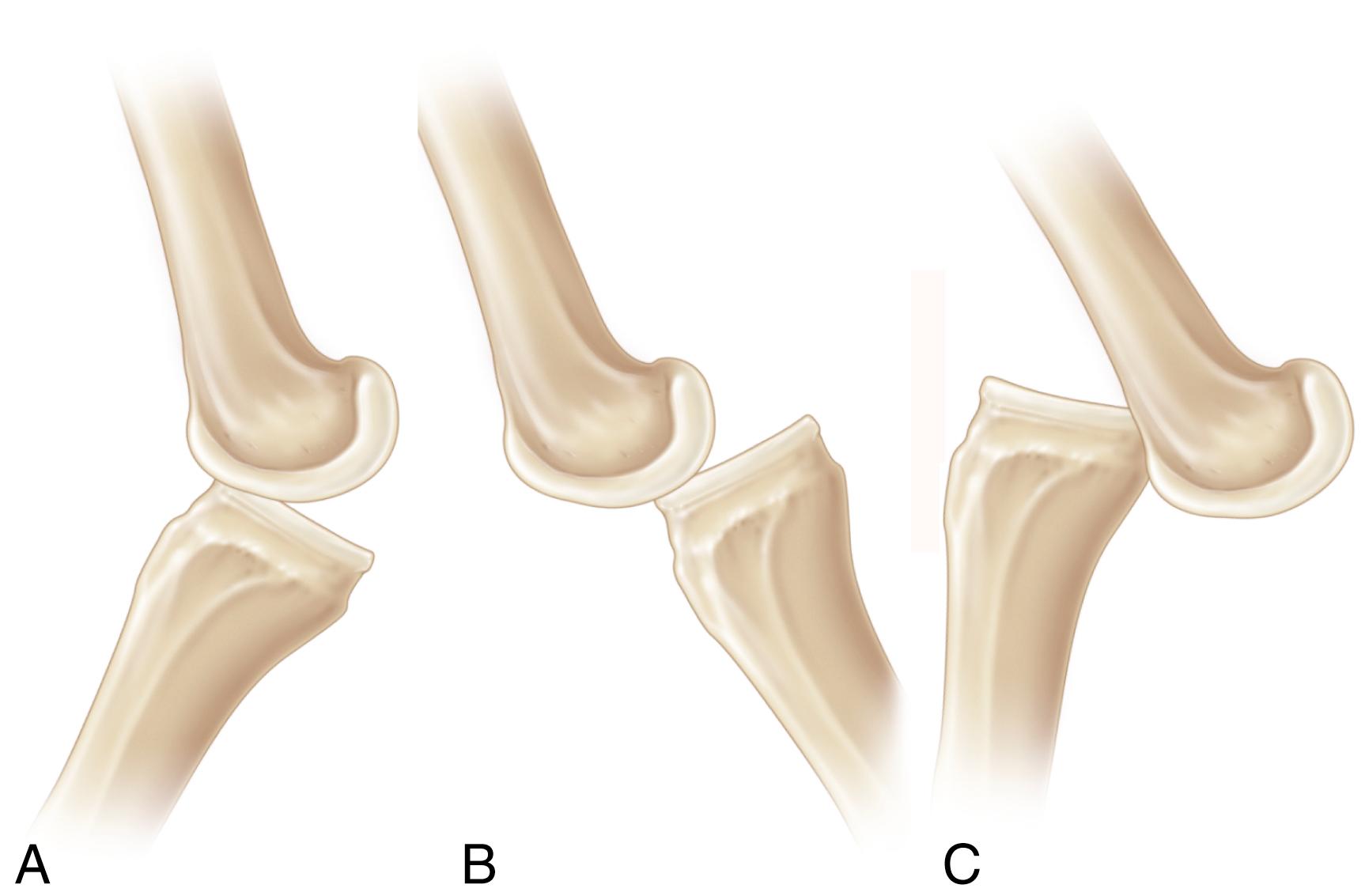
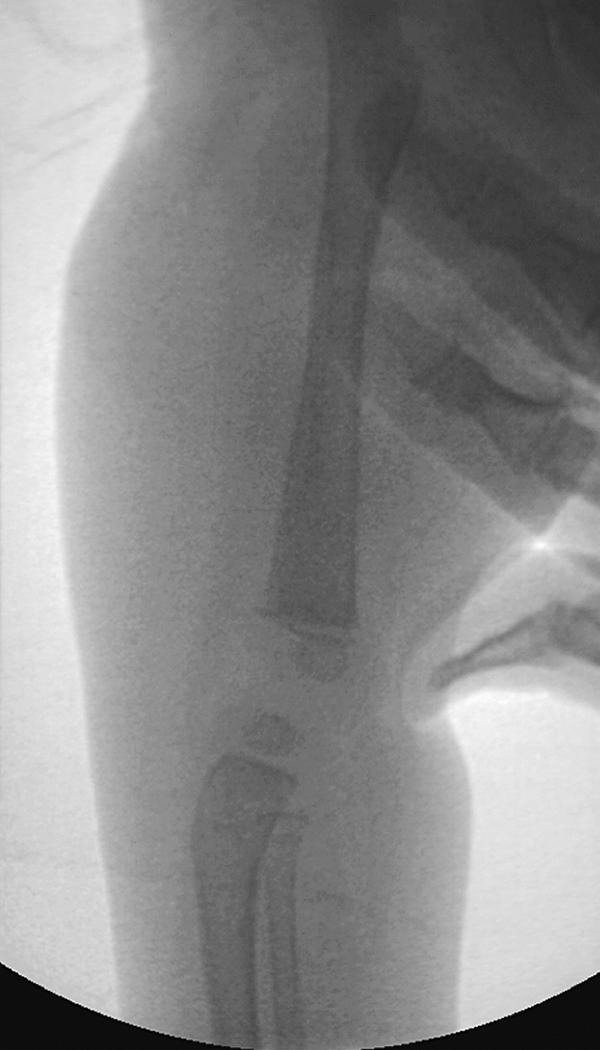
A search should be done for associated anomalies and syndromes at the time of the initial evaluation. Bilateral CDK is almost always syndromic, most commonly associated with laxity syndromes such as Larsen, Beals, or Ehlers-Danlos syndrome ( Fig. 18.4 ). Ipsilateral hip dislocation and clubfoot are present 70% and 50% of the time, respectively. Upper extremity, face, and gastrointestinal and genitourinary systems anomalies are not uncommon. Unilateral CDK may occur as an isolated musculoskeletal condition (with or without ipsilateral hip or foot deformity; Fig. 18.5 ) or may be associated with an underlying neurologic condition, such as arthrogryposis or spinal dysraphism. A person with spinal dysraphism may present with unilateral or bilateral CDK, or he or she may have one hyperextended knee and one knee with a flexion deformity.
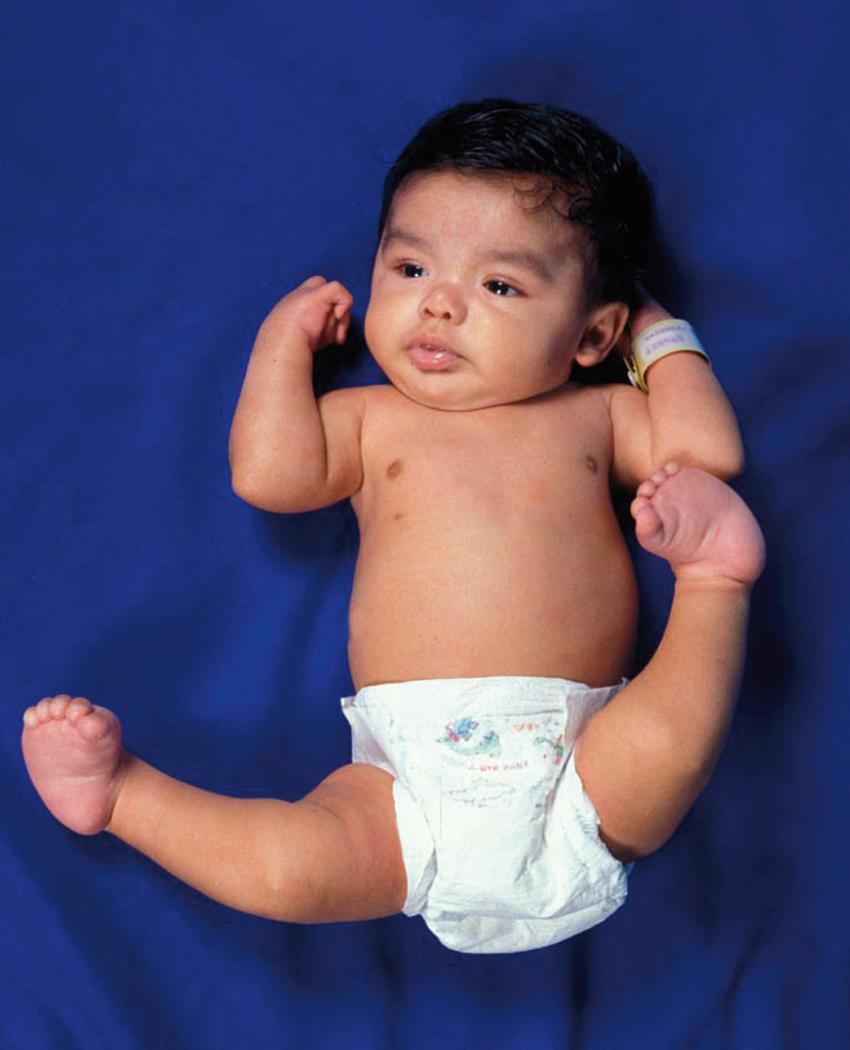
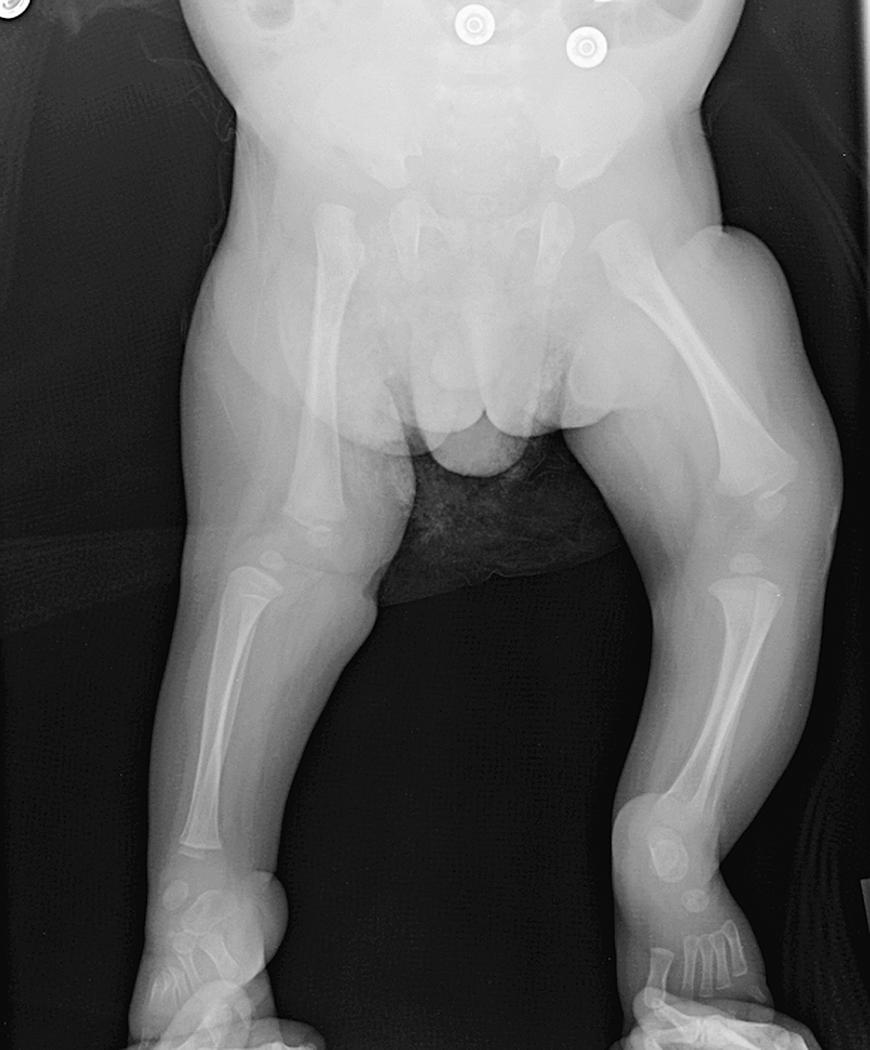
Whether isolated or syndromic, CDK is thought to be the result of abnormal fetal positioning. Once the abnormal position occurs, lack of movement because of neuromuscular conditions (e.g., arthrogryposis) or hyperlaxity leads to persistent hyperextension resulting in subsequent quadriceps atrophy and fibrosis. Hypoplasia of the patella and contracture of the iliotibial (IT) band are noted in CDK and may be the result of decreased in utero muscle and joint movement.
The degree of ligamentous laxity is variable in CDK. Elongation, insufficiency, or absence of the cruciate ligaments is at times a complicating feature of CDK. a
a References , , , , ,
We believe that cruciate ligament absence is more frequent in bilateral cases associated with laxity syndromes. Conversely, in isolated CDK, which is often unilateral, once the knee is reduced it is relatively stable.
Other pathologic findings in true CDK include anterior subluxation of the posterolateral and posteromedial structures, including hamstring tendons and the IT band. , , , The suprapatellar pouch may be atrophied or obliterated, with adhesions between a hypoplastic patella, the femur, and the IT band.
Nonoperative treatment should begin as soon as possible in infancy. The flexibility of the quadriceps can be assessed by applying gentle traction to the tibia and attempting flexion of the knee. The knee with congenital hyperextension can usually be corrected with gentle manipulation of the tibia into a flexed position. Longitudinal traction is applied to the tibia, and pressure is applied to the tibia in an anteroposterior direction to bring it around the femoral condyles. It is important to avoid a hinge type of flexion that will leave the tibia anteriorly subluxated on the femur. The new position is maintained in a cast or splint. Once 30 degrees or more of flexion is obtained, the knee will usually further flex to 90 degrees with one or two more manipulations. Forceful manipulation can produce fractures or epiphyseal injuries and should be avoided ( Fig. 18.6 ). Once 90 degrees of flexion is obtained, a removable splint can be used for a few months to maintain correction. Recurrence is unusual.
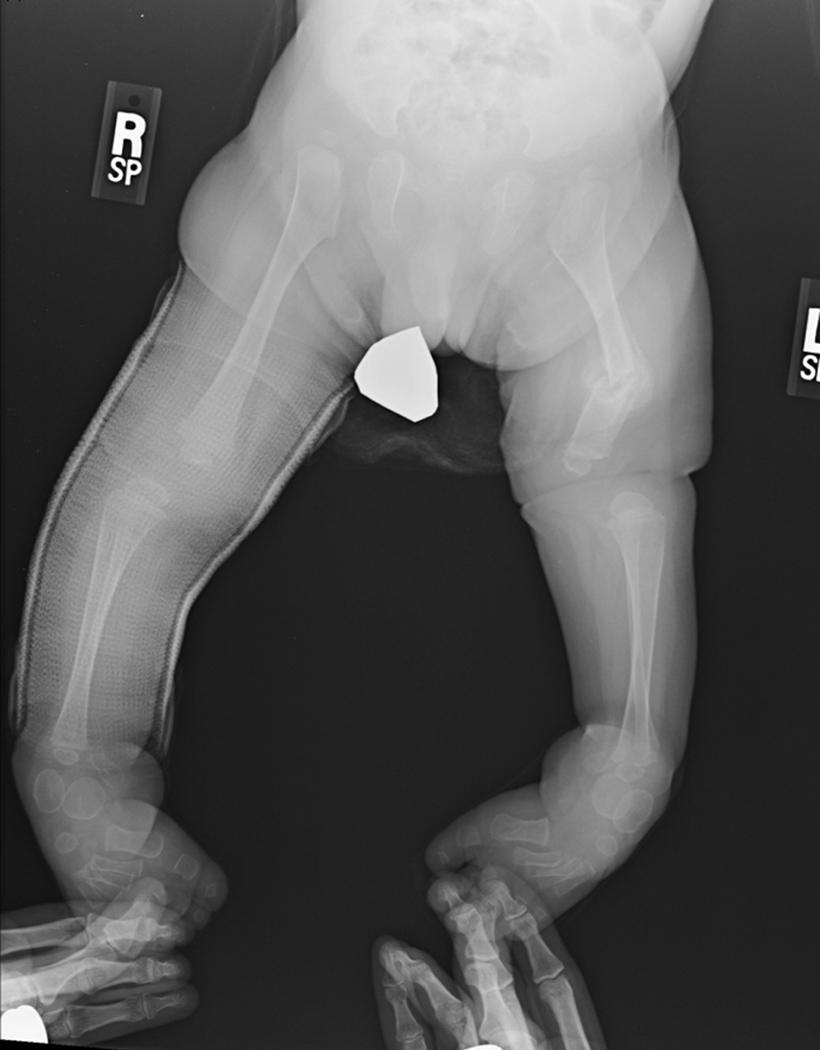
When a more severe quadriceps contracture prevents reduction, a block of the femoral nerve using a local anesthetic or a quadriceps block with botulinum toxin type A may allow further correction of the deformity. A trial of nonoperative management, with a neuromuscular blockade if necessary, may be effective if started before 12 months of age.
Surgical treatment for knees that do not respond to serial manipulations may be done as early as 6 months of age and probably should be initiated by 1 year of age. , The ideal age for treatment depends on the surgeon’s experience and often on the planned management of other lower extremity abnormalities.
The classic surgical approach to true CDK has been a V-Y quadricepsplasty combined with medial and lateral arthrotomies of the knee, which allow mobilization of the ligamentous structures that are anteriorly displaced ( Fig. 18.7 ). Historically, little attention has been paid to the redundant posterior capsule or the anterior cruciate ligament (ACL) deficiency. Unfortunately, the extensive quadriceps release required to obtain adequate length often results in weakness (which manifests itself in extensor lag) and fibrosis(which limits flexion). These features, combined with the redundant posterior capsule and ACL deficiency, may lead to recurrent anterior instability and even redislocation. In an unpublished review of 22 congenitally dislocated knees in 14 patients treated at Texas Scottish Rite Hospital for Children, we found nine knees treated with V-Y quadricepsplasty without ACL reconstruction that were unstable, had poor quadriceps strength, and required full-time bracing or other assist devices (i.e., crutches, walker, or wheelchair) for community ambulation. Eight of these nine unsatisfactory knees were in patients with laxity syndromes—predominantly Larsen-Johansson. As a result of this review, we have modified our approach to the patient with an ACL-deficient, congenitally dislocated knee and a laxity syndrome to include posterior capsulorrhaphy and ACL reconstruction. In addition, because of problems with extensive quadriceps scarring, we prefer to perform acute femoral shortening and avoid quadriceps lengthening.
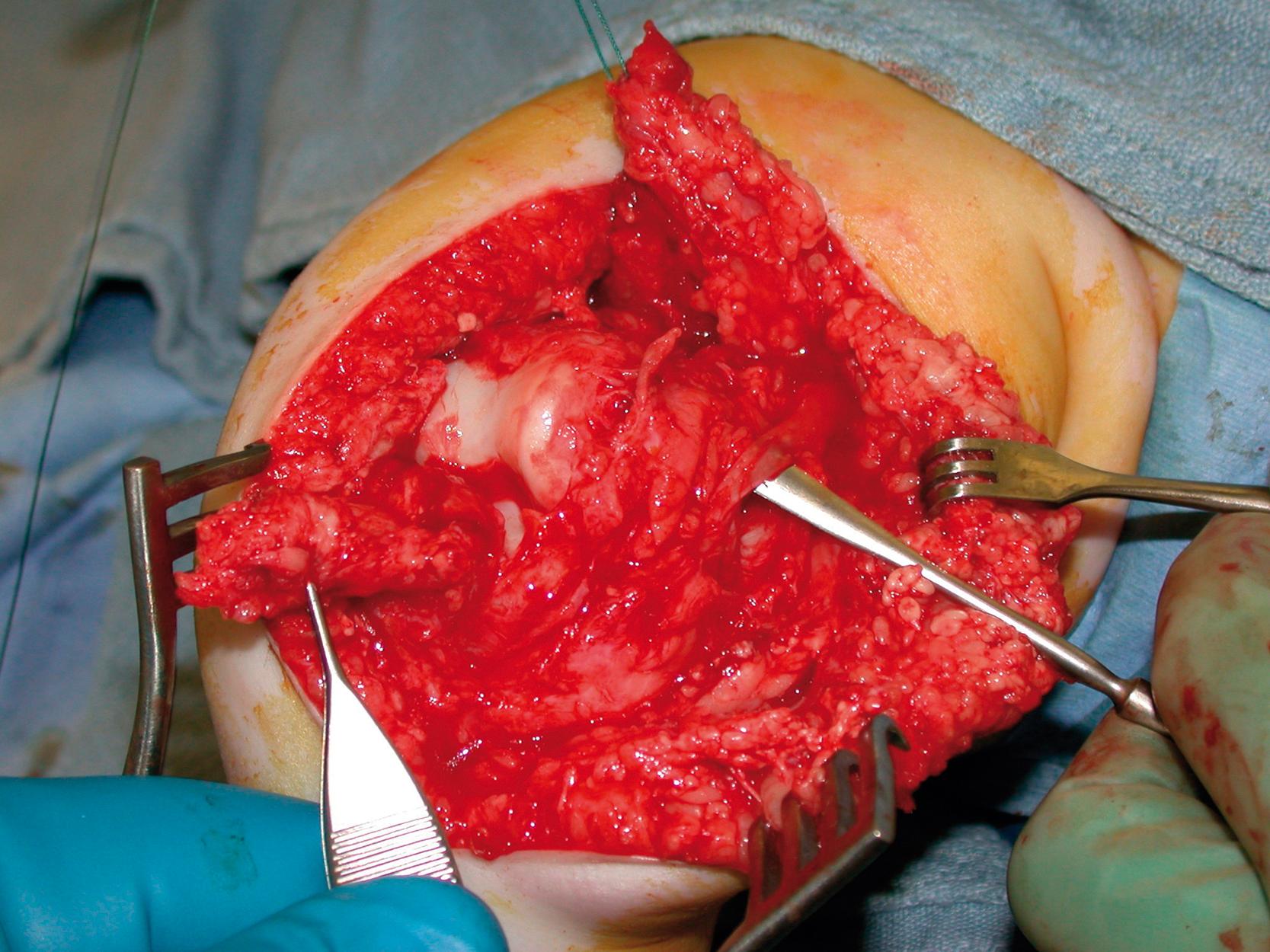
Preoperative planning begins with an assessment of all concomitant lower extremity deformities. The use of femoral shortening rather than V-Y quadricepsplasty allows simultaneous correction of hip and knee dislocations. Hip and knee deformities usually are corrected before any concomitant foot deformity. Patients with “hyperlaxity” syndromes are more likely to develop instability or redislocation. Patients with “neuromuscular dislocations,” such as arthrogryposis or myelomeningocele, are less likely to have redislocation but are more prone to postoperative stiffness. We have found that femoral shortening rather than extensive quadriceps lengthening produces weakness and fibrosis of the quadriceps.
The knee is approached through a midline longitudinal incision that extends proximally and laterally to facilitate lateral exposure of the femoral diaphysis. A lateral parapatellar arthrotomy is performed to mobilize the IT band and vastus lateralis. The quadriceps tendon, patella, and patellar tendon are mobilized through a medial arthrotomy. The biceps and pes anserinus tendons, which are usually subluxated anteriorly, are identified and mobilized after the medial and lateral arthrotomies. The femur is usually shortened 2 to 2.5 cm at the distal metaphyseal-diaphyseal junction. If a hip dislocation is being treated concomitantly, the femoral shortening may be done in the middiaphysis or the proximal metaphyseal–diaphyseal junction. Once the quadriceps are “functionally lengthened or decompressed” with femoral shortening, the patella can usually be stabilized in the intracondylar notch by advancing the vastus medialis and imbricating the medial capsule. At this point, the knee should be assessed to determine whether capsulorrhaphy or ACL reconstruction is necessary.
Because recurrent instability is common in patients with laxity syndromes, we often perform capsulorrhaphy with or without ACL reconstruction in this patient population. Instability is less common in patients with arthrogryposis, but they sometimes have recurrent or persistent subluxation resulting in limited flexion and may benefit from capsulorrhaphy. Capsulorrhaphy is performed at the posterior corner of the lateral femoral condyle after bluntly dissecting the capsule with the knee flexed. It is usually possible to excise 1 to 1.5 cm of the posterior lateral capsule ( Fig. 18.8 ). Once the posterior lateral capsulorrhaphy is completed, we make a 3- to 4-cm incision behind the medial femoral condyle. This incision is localized by placement of a blunt instrument from lateral to medial, posterior to the femoral condyles, and anterior to the capsule. Medial capsular dissection is carried out with the knee flexed and the gastrocnemius muscle retracted posteriorly. Consideration should be given to shortening of the hamstrings in conjunction with the capsulorrhaphy. , , , At the completion of the capsulorrhaphy, the knee should lack 30 degrees of full extension and should flex to at least 90 degrees. It has been our experience that this flexion contraction will stretch in the first postoperative year.
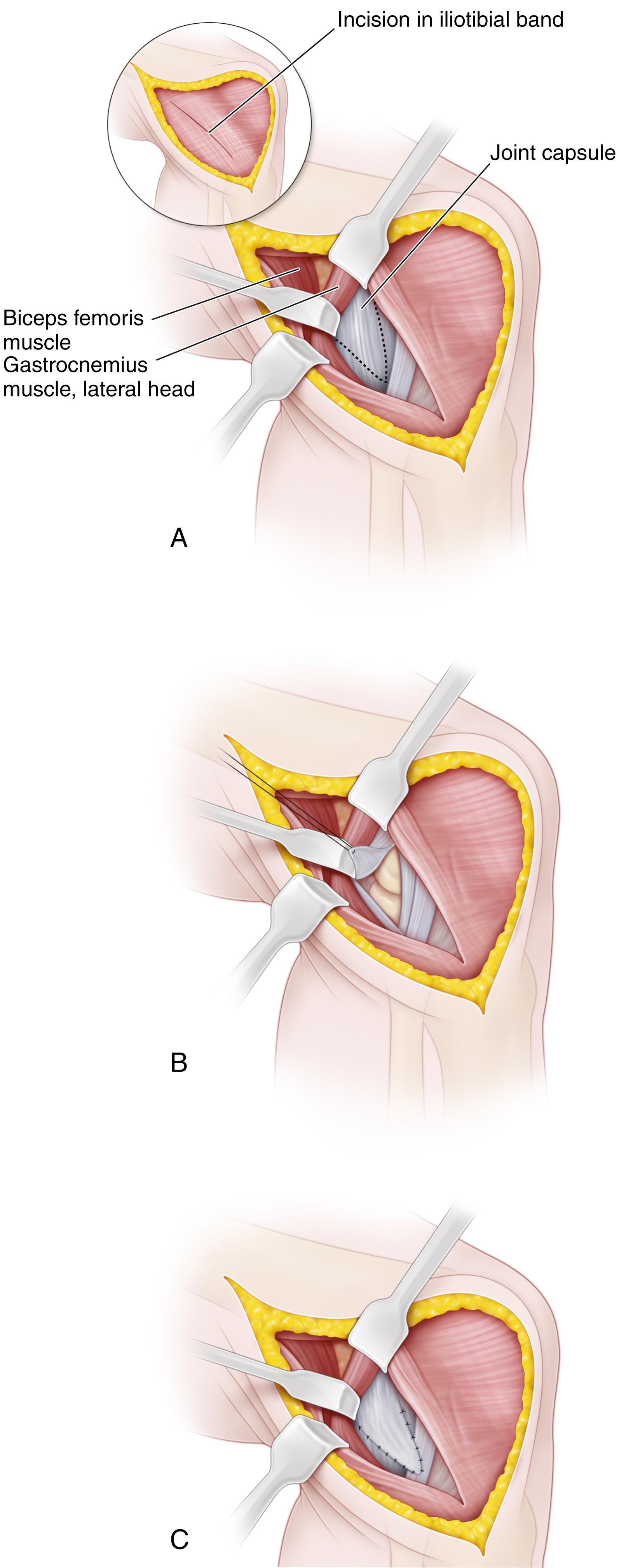
If the ACL is absent and the patient has a hyperlaxity syndrome, we believe consideration should be given to ACL reconstruction. Our preferred technique for ACL reconstruction is the antegrade IT band transfer described by Insall ( Fig. 18.9 ). , , The IT band is taken off its insertion on Gerdy tubercle and mobilized proximally. The tendon is then tubularized and distally rerouted “over the top” of the lateral femoral condyle and through the intercondylar notch. The distal reattachment into the proximal tibia can be either through a drill hole entirely within the epiphysis or through a more vertical transphyseal tunnel. The major advantage of this technique is that, left in its anatomic location, the IT band is a deforming force, producing hyperextension, valgus, and external tibial rotation—thus rerouting it may actually prove beneficial. In addition, rather than a simple passive restraint, it is an active transfer. The biggest disadvantage of this technique is the potential for physeal injury. We believe this risk can be mitigated using an entirely epiphyseal tunnel, advancing the tendon through the epiphyseal drill hole and securing it by a button on the skin of the anterior tibia. Care should be taken when drilling the epiphyseal tunnel to avoid damage to the physis (particularly anteriorly) and to ensure that the tunnel is through bone rather than cartilage to facilitate tendon ingrowth.
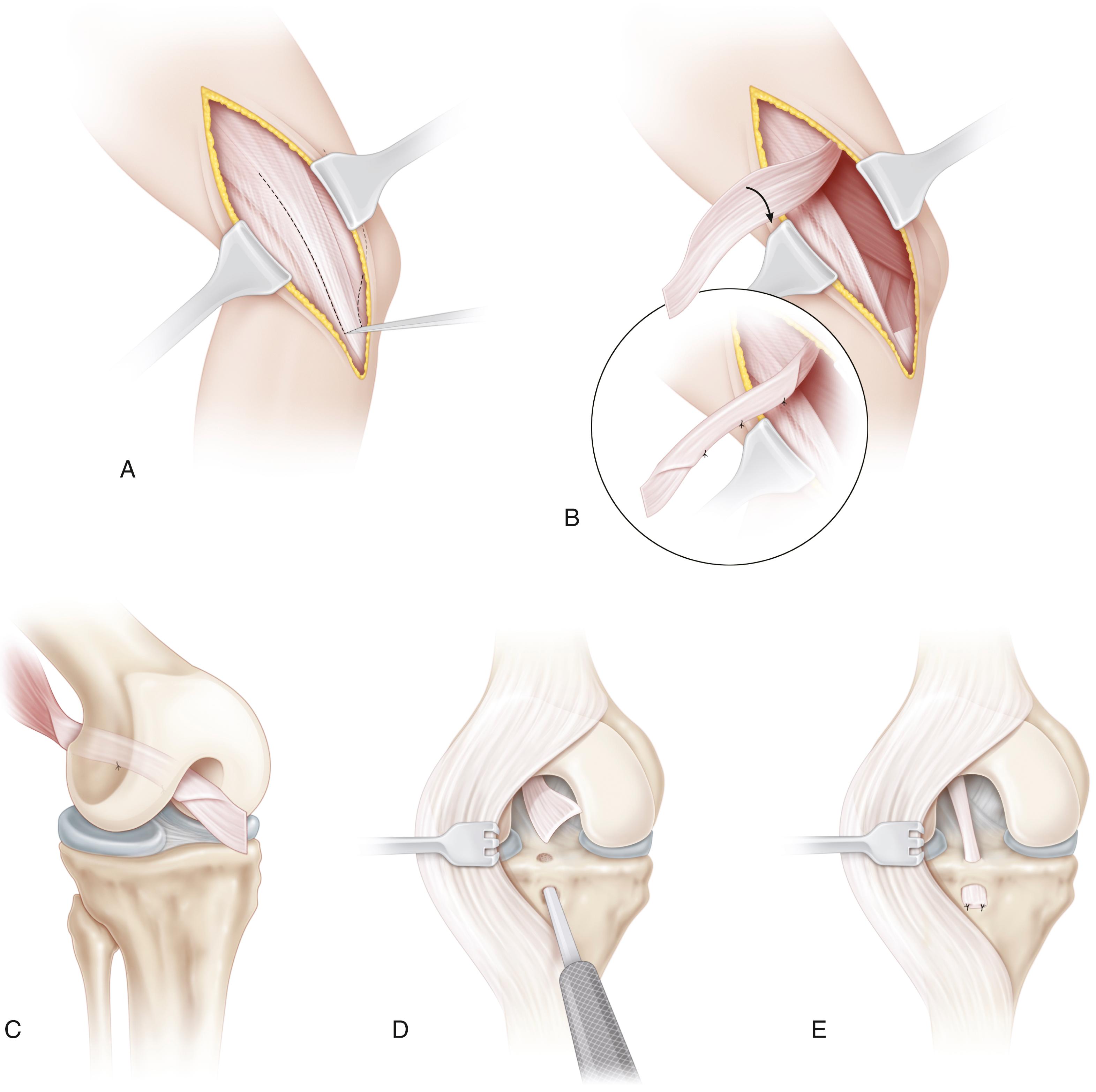
Patellofemoral instability is a common and diverse condition familiar to all orthopaedists, whereas congenital dislocation of the patella is a rare condition that presents with a laterally displaced, hypoplastic patella. These patients usually have varying degrees of flexion and valgus contracture of the knee, as well as external rotation of the tibia ( Fig. 18.10 ). The most severe forms of congenital dislocation of the patella are associated with a significant knee flexion contracture that is readily apparent at birth. Often the patella is not palpable in these patients because it is both hypoplastic and nearly adherent to the lateral femoral condyle. At the other end of the spectrum are patients with a more mobile patella that actually may be “reducible” when the knee is flexed. These more mildly affected patients may be unable actively to extend the knee from full flexion but have normal ability to maintain knee extension once it is attained and the patella is reduced.

Although Goldthwaite described surgical treatment of patellar dislocation in 1899 and Conn described vastus medialis obliquus (VMO) advancement in 1925, it was not until 1976 that Stanisavljevic and colleagues attributed congenital dislocation of the patella to aberrant fetal myotome development. They noted that laterally placed thigh structures rotate internally in the first trimester of embryologic development and hypothesized that congenital dislocation of the patella was the result of failure or disruption of this rotation, leaving the patella laterally displaced along the lateral femoral condyle.
Congenital patellar dislocation presents with a spectrum of severity. The most severe forms have significant knee flexion contractures that make the diagnosis evident in infancy. However, more mildly affected individuals may not present until school age, when relative quadriceps weakness begins to present functional problems. Radiographs may be difficult to interpret because the patella does not normally ossify until approximately 3 years of age, and this may be delayed even further in the presence of congenital dislocation. In severe cases, radiographic assessment is also complicated by the fact that the patella may become nearly confluent with the lateral femoral condyle.
Congenital dislocation of the patella usually requires surgical reconstruction that involves “medializing” the entire extensor mechanism. This is accomplished with extensive lateral release and advancement of the VMO distally and medially. In more severe cases, the IT band may need to be divided transversely and the quadriceps may be lengthened by either V-Y plasty or femoral shortening. Although some authors have advocated a skin incision that extends to the proximal femoral metaphysis, we believe that an extensive lateral release can be performed through a more limited distal incision. In our experience, to achieve adequate medial realignment the vastus lateralis should be mobilized from the intramuscular septum. We believe this can be accomplished without an extensive skin incision. In addition to the lateral release and medial reefing, more severe cases will require medialization of the patellar tendon. In such cases, we prefer the Goldthwait transfer of the lateral half of the tendon rather than complete release and reinsertion, , primarily because of the lower risk of physeal injury. Before skin closure, we expect 50 to 70 degrees of flexion without lateral dislocation of the patella. Patients are casted in 10 to 20 degrees of flexion for 6 to 8 weeks. Aggressive quadriceps rehabilitation is necessary after cast removal. Parents should be counseled that an active extensor lag will persist for 3 to 12 months.
The results of quadriceps realignment for congenital dislocation of the patella are poorly documented. Recurrent dislocation has been reported in up to 10%. , , Persistent extensor lag has also been noted—particularly in patients with an underlying skeletal dysplasia or neuromuscular condition such as arthrogryposis. Both medial redislocation and peroneal nerve palsy have also been reported. ,
Patients with Down syndrome and patellofemoral instability—whether congenital or acquired—are more difficult to treat because of recurrent dislocation. Patellofemoral instability has been reported in up to 8% of patients with Down syndrome. However, many of these patients are asymptomatic. , When considering “prophylactic intervention” in the minimally symptomatic or asymptomatic patient with Down syndrome, it is important that successful results have been reported in 86% of patients who had functional impairments before reconstruction.
Deformities of the tibia and fibula are common and clinically obvious abnormalities that affect a child’s lower extremity. Whether the deformity is congenital or acquired, physiologic or pathologic, all draw attention because of the real or apparent effect they have on gait. Most lower leg deformities are physiologic and resolve spontaneously, and early recognition of the benign nature of such changes is as important as the correct diagnosis of true pathologic conditions. Understanding and diagnosing these physiologic changes can reassure parents and avoid unnecessary treatment. The various conditions affecting the lower part of the leg are discussed in this chapter in relation to their anatomic occurrence.
Genu varum (bowlegs) is an extremely common pediatric deformity and rarely requires treatment in patients under 24 months of age. Determining whether the condition represents physiologic genu varum or a pathologic process, such as infantile tibia vara, is critical because the prognosis and treatment differ profoundly.
Physiologic genu varum is defined by a tibiofemoral angle of at least 10 degrees of varus, a radiographically normal physis, and apex lateral bowing of the proximal end of the tibia and often the distal end of the femur. , The legs of most newborns are typically bowed with 10 to 15 degrees of varus angulation. When the infant begins to stand and walk, the bowing may appear more prominent and often seems to involve both the tibia and the distal part of the femur. Concomitant internal tibia torsion may exacerbate the deformity ( Fig. 18.11A ). Children with physiologic genu varum and internal tibial torsion typically come to medical attention after standing age (between 12 and 24 months), usually because of parents’ concern about the appearance of the legs and often with an intoeing complaint. These children have no other significant findings on clinical examination. Typically, radiographs are not needed. If obtained, radiographs may show an apparent delay in ossification of the medial side of the distal femoral and proximal tibial epiphyses (see Fig. 18.11B ) or flaring of the medial distal femoral metaphysis; however, the physes have a normal appearance.
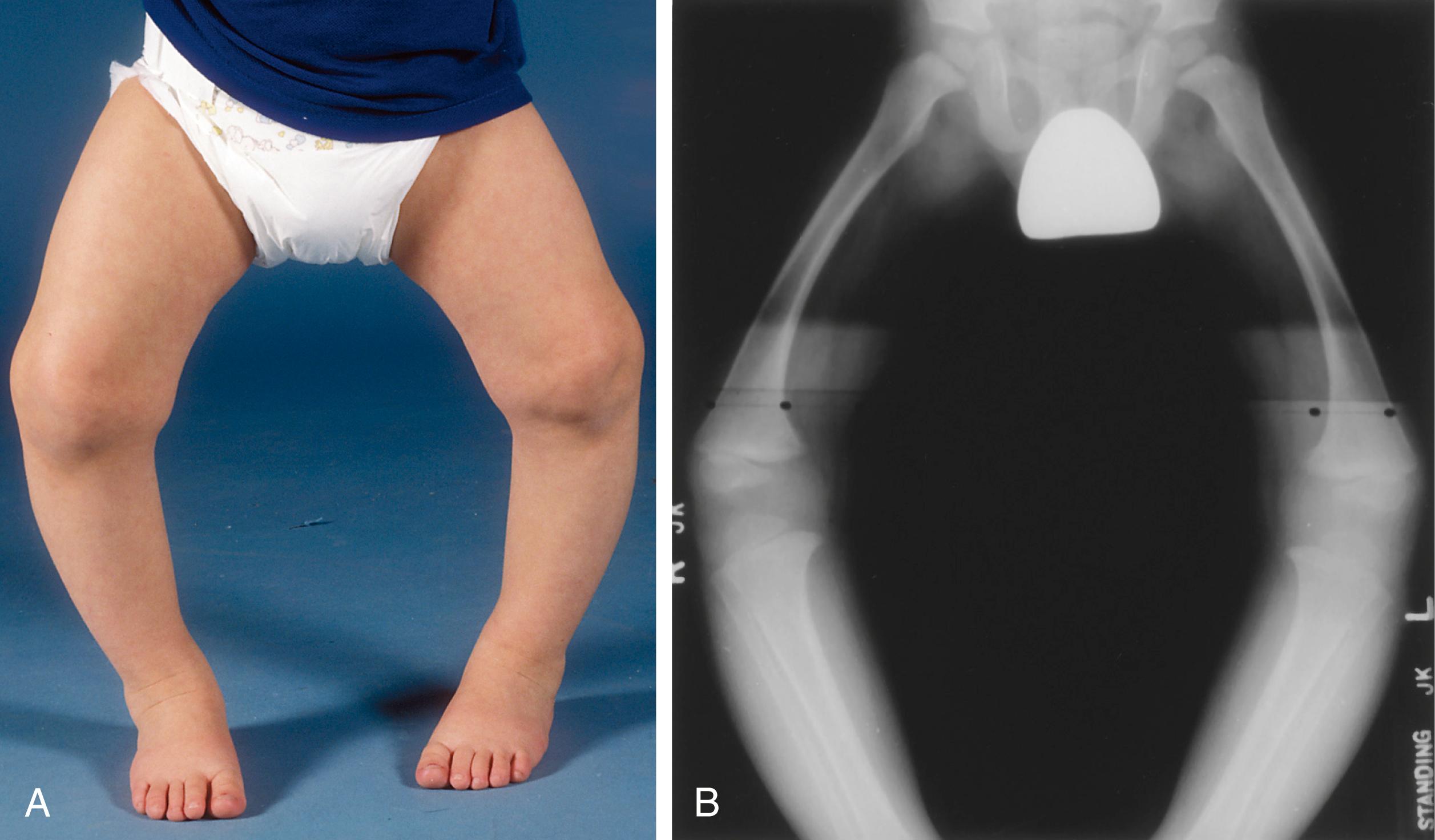
Clinical measurements of the tibiofemoral angle and intercondylar distance in normal children show maximal varus at 6 to 12 months old, neutral alignment by 18 to 24 months, maximal genu valgum at 4 years (8 degrees of tibiofemoral valgus), and a gradual decrease in genu valgum to a mean of 6 degrees by the age of 11 years. The presence of genu varum in children older than 2 years can be considered abnormal, but this expected pattern of change over time from genu varum to genu valgum is an average, and variations outside of these ages may be observed ( Fig. 18.12 ). A distinct subset of patients with more severe varus angulation at initial evaluation, slower resolution to neutral alignment by 3 to 4 years old, and radiographic femora vara have been described.
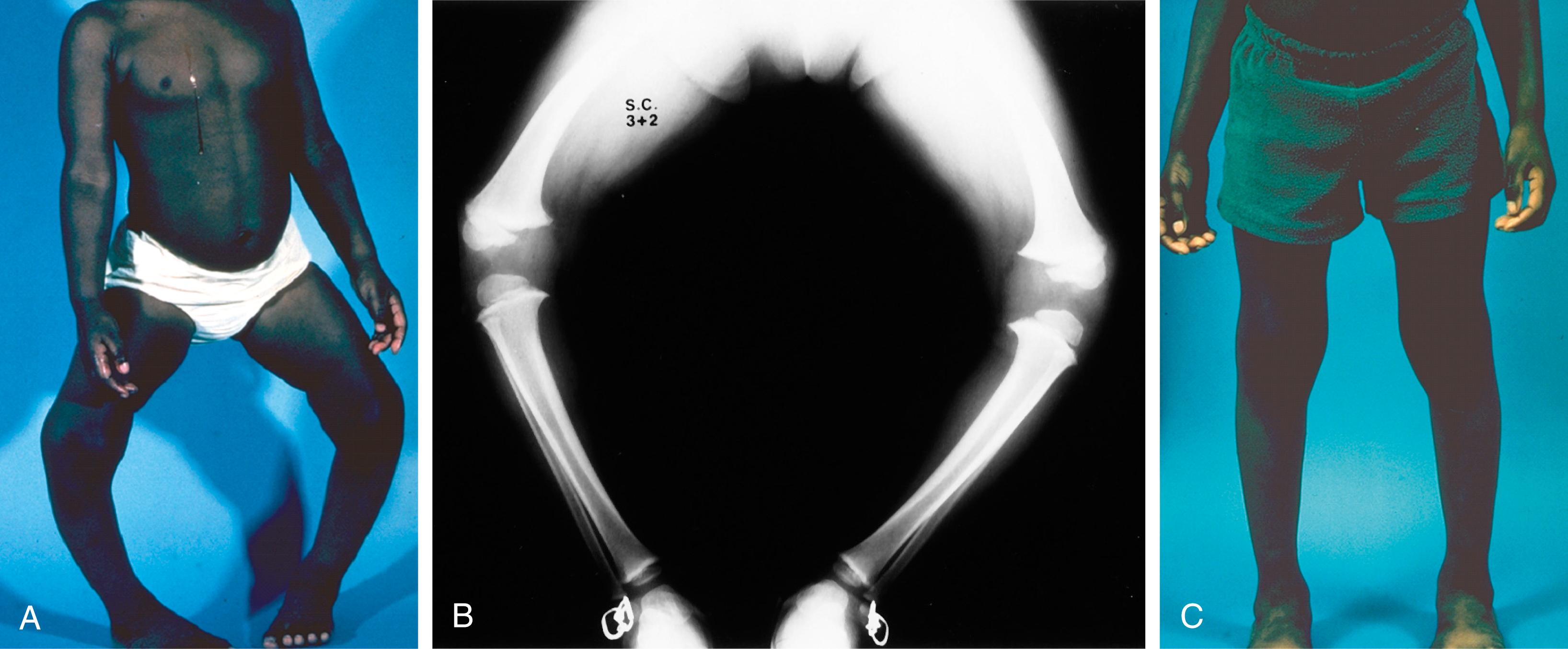
Spontaneous resolution of the varus to neutral tibiofemoral alignment by 24 months old and to an adult valgus alignment after 3 years old is well-documented ( Fig. 18.13 ). , Parents are reassured that the condition is usually self-correcting, but they should also be advised that reevaluation with radiographs are warranted if the varus deformity persists or progresses beyond 24 months old. Also concerning are patients with distinctly asymmetrical varus changes. These patients with an obvious side-to-side difference should be more closely followed and radiographs obtained.

Tibia vara is defined as growth retardation at the medial aspect of the proximal tibial physis resulting in persistent or progressive bowing and possible epiphyseal changes as well. Traditionally, two forms of the deformity are recognized based on age at onset of the condition: infantile tibia vara, if present in patients younger than 3 years, and adolescent tibia vara, if developing in children 8 years of age or older. Infantile tibia vara is more common. As patients may present between 3 and 10 years of age, a third category has been defined as juvenile in onset. ,
Late-onset tibia vara includes both the juvenile and the adolescent forms, but there are differences of opinion regarding whether late-onset tibia vara describes classic adolescent tibia vara or is a distinct entity. b
a References , , , , , .
We have not found these distinctions useful and continue to classify tibia vara as either infantile, juvenile, or adolescent, and “late-onset” tibia vara being synonymous with adolescent tibia vara.
Infantile tibia vara, first described by Erlacher in 1922, is best known as Blount disease after the classic description in 1937. Blount characterized the deformity as an abrupt angulation just below the proximal physis, an irregular physeal line, and a wedge-shaped epiphysis with a “beak” at the medial metaphysis ( Fig. 18.14 ). Apparent lateral subluxation of the proximal end of the tibia is often present.
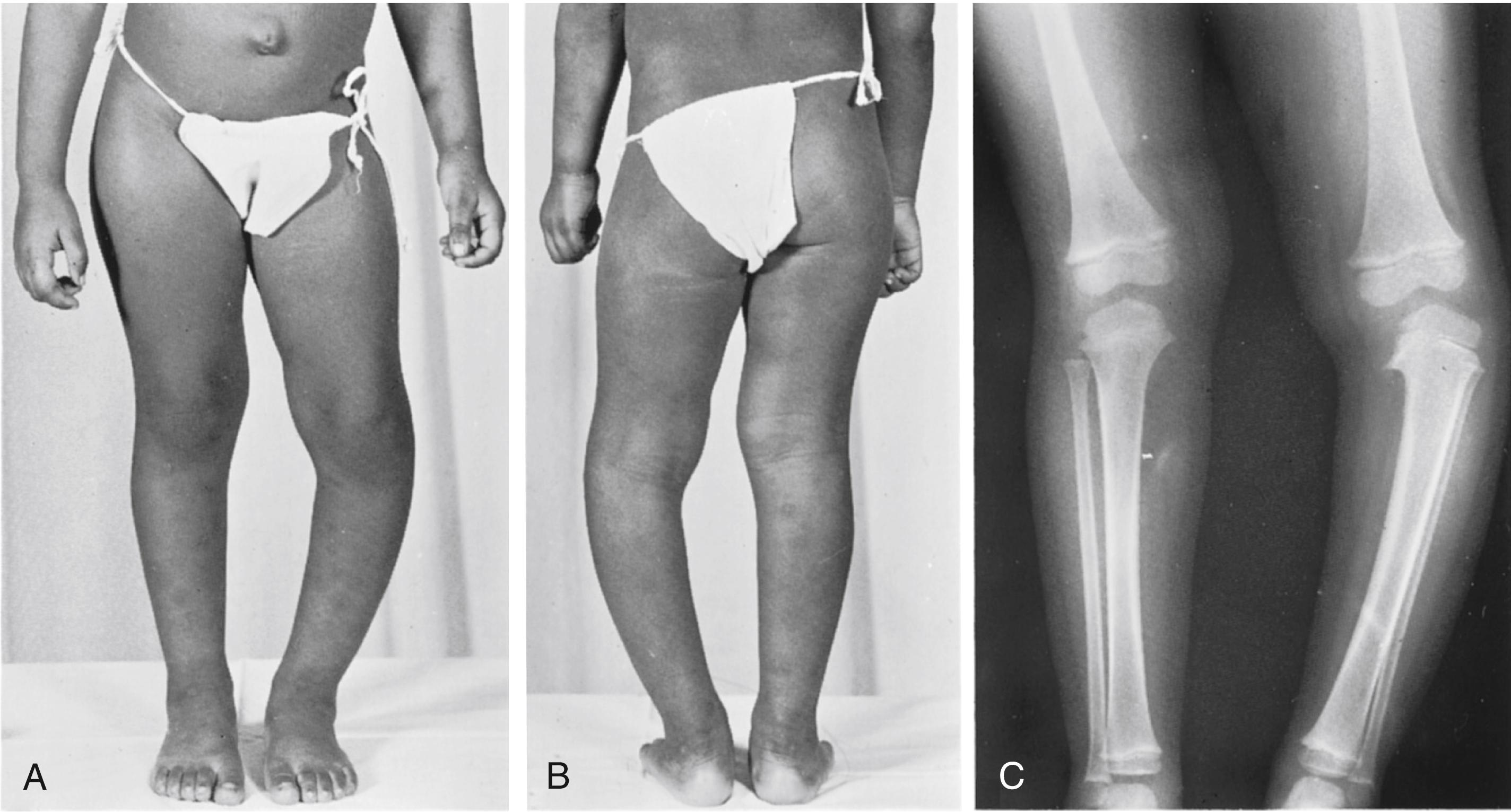
Several authors have reported a familial occurrence of the condition, , , , , and one report of infantile tibia vara in a family suggested that the disease may be inherited as an autosomal dominant condition with variable penetrance. Other studies have found no evidence of an inherited condition and have concluded that the etiology is multifactorial. As the radiographic features of infantile tibia vara have never been seen in patients younger than 1 year, and rarely in patients younger than 2 years, the condition is not considered a congenital disorder but rather developmental.
Histologic findings of the affected physis and corresponding metaphysis in infantile tibia vara have included (1) islands of densely packed cartilage cells displaying greater hypertrophy than expected from their position in the physis, (2) islands of nearly acellular fibrocartilage, and (3) exceptionally large clusters of capillary vessels. , The physeal cell columns become irregular and disordered in arrangement and normal endochondral ossification is disrupted in both the medial aspect of the metaphysis and physis. The varus deformity progresses as long as ossification is defective and growth continues laterally.
The typical child with infantile tibia vara may appear similar to a child with physiologic genu varum; however, patients with true infantile tibia vara are often obese and present with a lateral thrust in gait. Tibia vara patients may exceed the 95th percentile for weight and have much higher body mass index (BMI) measurements. , , Finite element analysis of the knee has shown that a compressive force sufficient to retard physeal growth by the Hueter-Volkmann principle is produced on the medial tibial plateau of a 2-year-old in the 90th percentile for body weight and with a 20-degree varus deformity during single-limb stance. Greater radiographic varus malalignment and procurvatum deformity has been correlated with higher BMI in infantile tibia vara. This relationship between obesity and risk for Blount disease may warrant early intervention and nutrition counseling in young patients.
A clinically apparent lateral thrust of the knee during the stance phase of gait that resembles a limp is present in many patients with tibia vara (see Fig. 18.14 ). This sudden lateral knee movement with weight bearing is caused by varus instability at the joint line. The presence of a lateral thrust, though not pathognomonic for infantile tibia vara, is an indication for radiographs, regardless of the patient’s age.
A standing anteroposterior view of the lower extremities from hip to ankle should be obtained when initially evaluating a patient for possible tibia vara. When tibia vara is present, radiographs demonstrate (1) a sharp varus angulation in the metaphysis, (2) a widened and irregular physeal line medially, (3) a medially sloped and irregularly ossified epiphysis, and (4) prominent beaking of the medial metaphysis with lucent cartilage islands within the beak (see Fig. 18.14 and Box 18.1 ). , ,
Varus angulation at the epiphyseal-metaphyseal junction
Widened and irregular physeal line medially
Medially sloped and irregularly ossified epiphysis, sometimes triangular
Prominent beaking of the medial metaphysis with lucent cartilage islands within the beak
Lateral subluxation of the proximal end of the tibia
A procurvatum (apex-anterior angulation) sagittal plane deformity is also present. While the coronal deformity is most obvious, failure to recognize, and potentially correct, the sagittal plane can result in poor outcomes. It has been shown the radiographic measure of procurvatum is often greater than appreciated on clinical examination alone.
Unequivocal radiographic changes diagnostic of infantile tibia vara are rarely observed before 18 months old; the youngest published case was radiographically diagnosed at 17 months old. Levine and Drennan measured the tibial metaphyseal–diaphyseal angle (MDA) as an aid in determining toddlers at risk for developing tibia vara. The MDA is the angle created by the intersection of a line connecting the most prominent medial portion of the proximal tibial metaphysis (the “beak”) and the most prominent lateral point of the metaphysis with a line drawn perpendicular to the long axis of the tibial diaphysis ( Fig. 18.15 ). Blount lesions visible on radiographs subsequently developed in 29 of 30 patients whose MDA was greater than 11 degrees, whereas such changes developed in only three of 58 patients with an angulation of 11 degrees or less. Unfortunately, subsequent studies measuring the MDA, the tibiofemoral angle, or the mechanical axis have not improved early detection of infantile tibia vara. , Limb malrotation during radiographic examination can affect the measured MDA and the tibiofemoral angle. , Although measurement of the MDA may have some prognostic accuracy, by itself, it is not reliable to diagnose impending infantile tibia vara. , ,

The tibial epiphyseal–metaphyseal angle has been proposed as an adjunctive measurement to aid early diagnosis of infantile tibia vara. An angle greater than 20 degrees in combination with an MDA greater than 10 degrees indicates a toddler at risk. However, true infantile tibia vara cannot be diagnosed without the unequivocal presence of the characteristic lesion in the proximal medial tibial metaphysis. Although patients with large MDAs may be at risk for the development of infantile tibia vara and must be monitored, we currently recommend no treatment before the appearance of the Blount lesion, which is often present by 24 months of age.
Attempts to use magnetic resonance imaging (MRI) to assess the growth disturbance in infantile tibia vara are ongoing. , MRI characterizes the extent of the ossified and cartilaginous epiphysis, along with any physeal anatomic disruption ( Fig. 18.16 ). While not necessary to confirm the diagnosis, such imaging studies are useful preoperative tools to evaluate location and size of the physeal bridge (see Fig. 18.16D and E ), as well as the presence or absence of “true” intraarticular deformity (see Fig. 18.16A–C ). MRI assessment of physeal function to determine whether the physis is bridged or sufficiently disrupted, in order to predict cessation of medial growth, is not yet proven to be accurate.
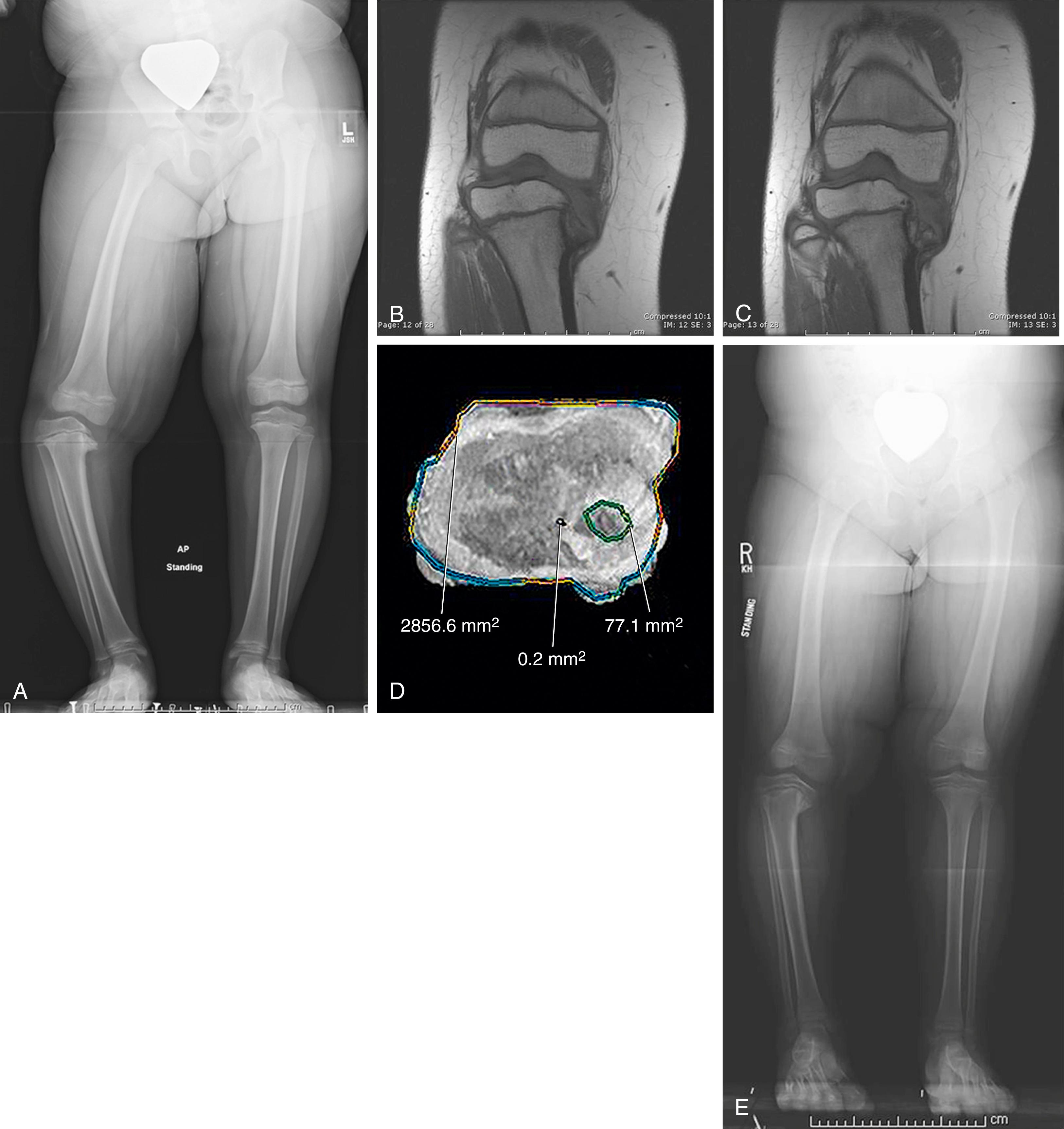
An MRI study comparing infantile Blount patients with normal controls (with an average age of approximately 5 years) supports early changes in the medial tibial epiphysis. Inferomedial inclinations in the coronal plane and inferior inclinations in the posterior slope of the tibia in the sagittal plane were observed. Others dispute this finding and consider actual depression of the posteromedial tibial articular surface to be rare in younger children. The “deficiency” is considered unossified abnormal fibrocartilage whose delay in ossification produces the appearance of a defect and is directly related to the underlying histopathology. Ligamentous laxity on the lateral side of the knee frequently develops in a neglected or recurrent deformity.
In later evaluated or “relapsed” cases of infantile tibia vara, a more severe bony deformity, including depression and sloping of the posteromedial epiphyseal surface, has been identified by computed tomography (CT) ( Fig. 18.17 ). , , However, CT lacks the added benefit of visualizing the cartilaginous articular surface, which may occupy most of the medial plateau. The occurrence of “true” intraarticular deformity in young patients is debatable. Patients younger than 6 years old have not demonstrated such plateau depression as demonstrated by intraoperative arthrography showing preservation of a normal-appearing joint line despite the osseous defect ( Fig. 18.18 ). However, the clinical finding of lateral thrust and the radiographic appearance of lateral tibial subluxation on the femur could be explained by the presence of such a defect from the outset.
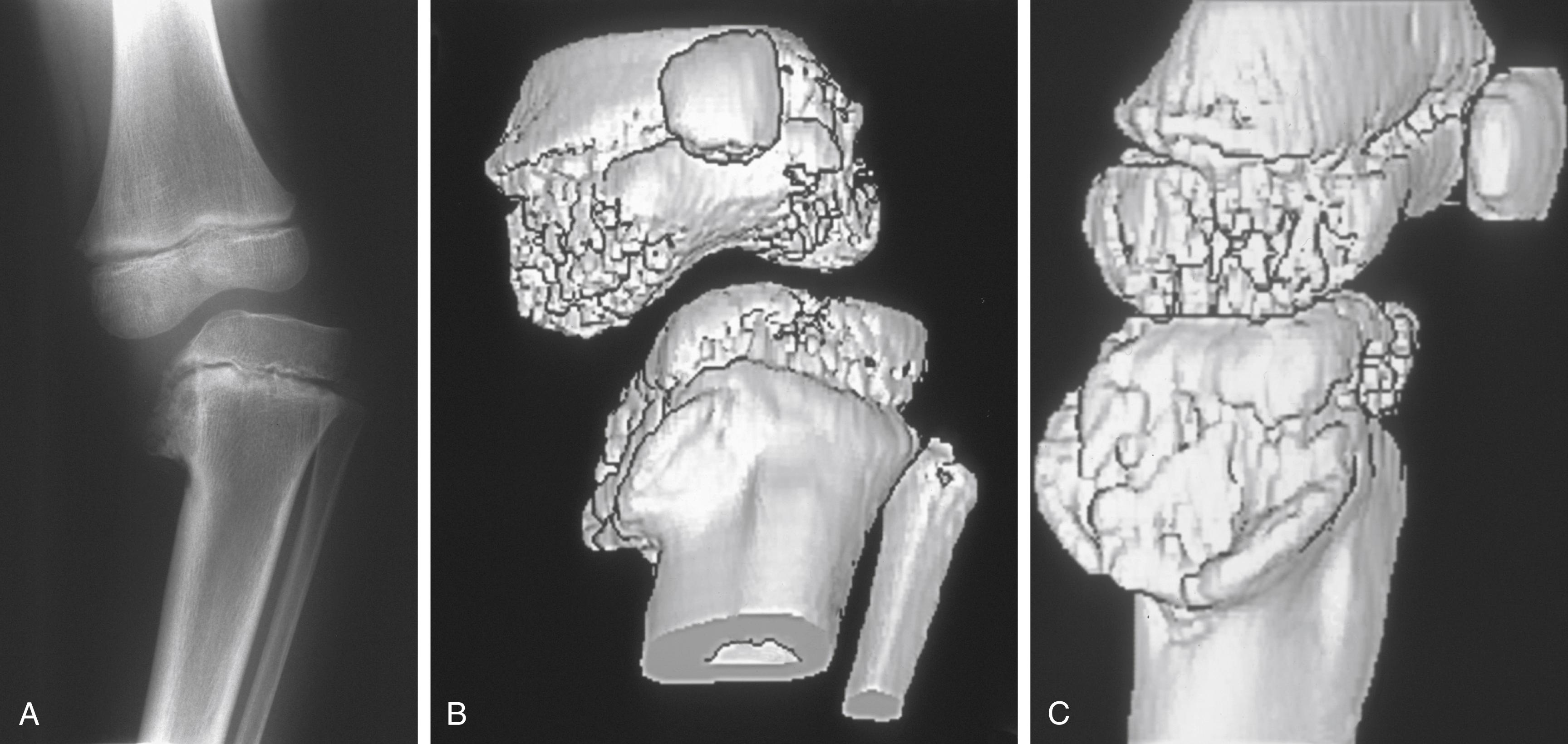
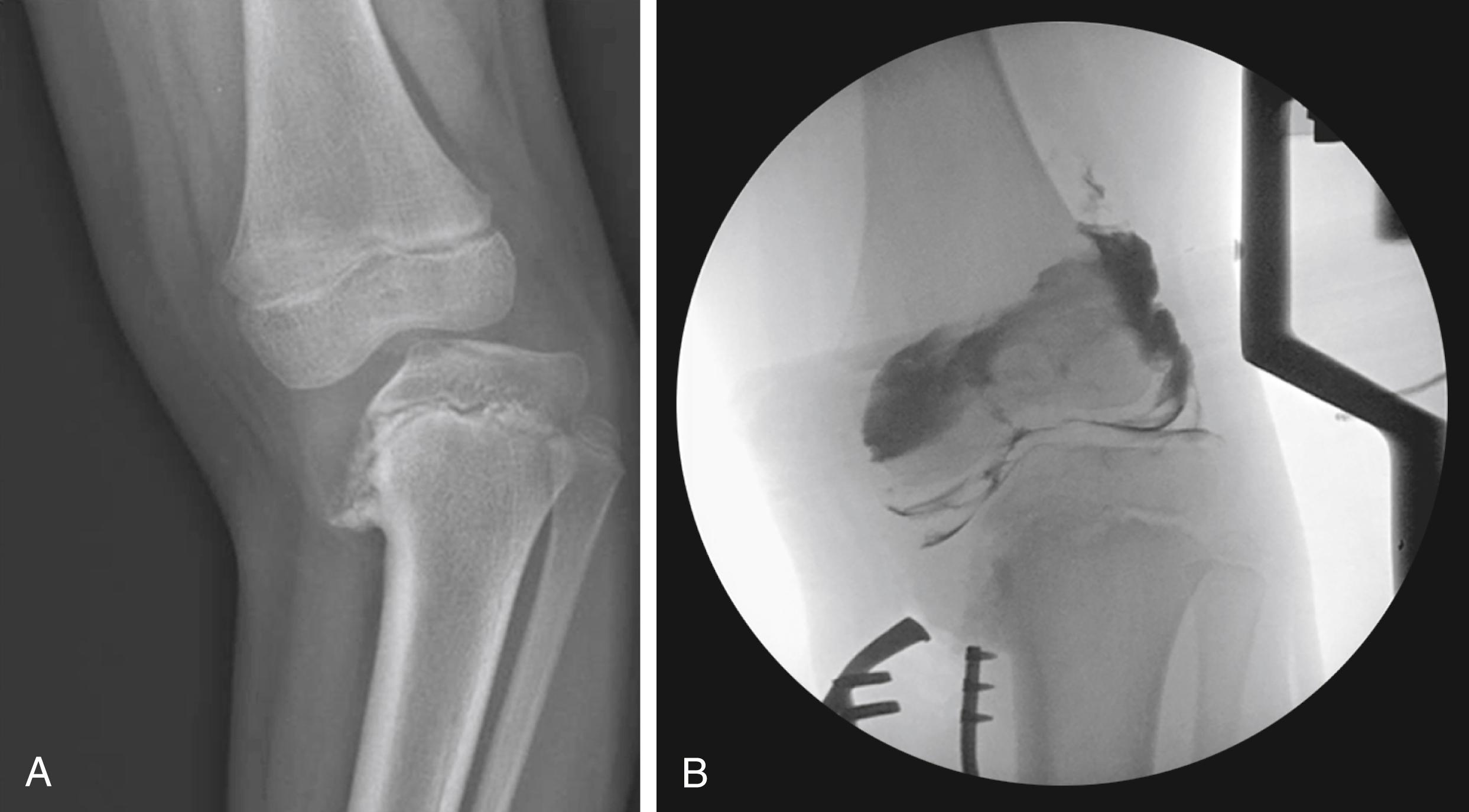
The most common entity in the differential diagnosis in young children is physiologic genu varum, in which no Blount lesion is seen and the physis and epiphysis are radiographically normal.
Non-physiologic causes of genu varum include skeletal dysplasias (e.g., metaphyseal chondrodysplasia, spondyloepiphyseal dysplasia, multiple epiphyseal dysplasia, achondroplasia), metabolic diseases (e.g., renal osteodystrophy, vitamin D–resistant rickets), posttraumatic deformity, postinfectious sequelae, and proximal focal fibrocartilaginous dysplasia (FFCD).
In 1952, Langenskiöld classified infantile tibia vara according to the degree of metaphyseal-epiphyseal changes seen on radiographs, with six stages varying with advancing age ( Fig. 18.19 ). , Restoration to normal was common after treatment in disease stages I and II and possible in stages III and IV, whereas disease stages V and VI were associated with recurrence and irreversible radiographic changes. , ,
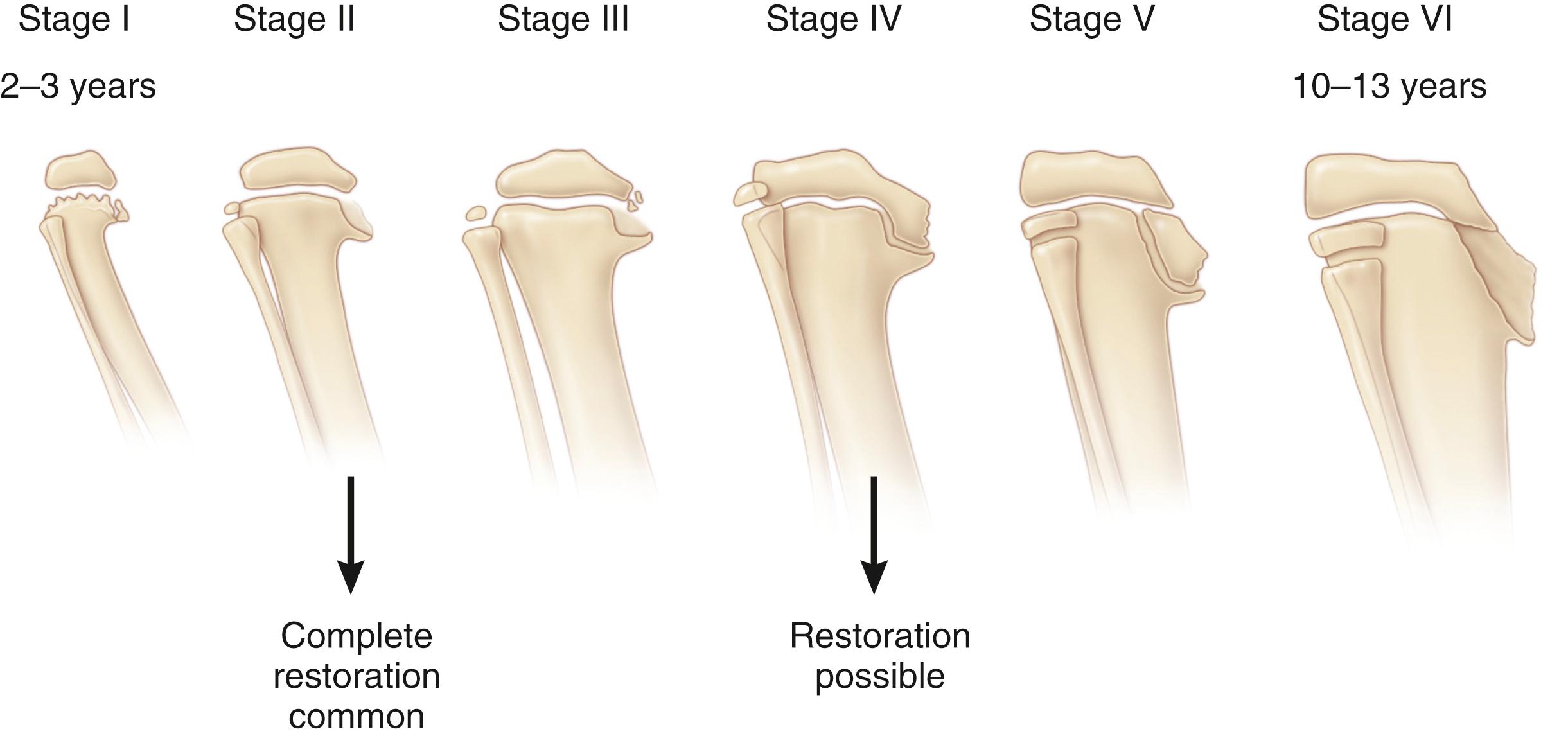
Although Langenskiöld’s classification was primarily intended to be a radiographic description of infantile tibia vara, prognostic implications have gradually been de-rived. , , In 1964, Langenskiöld and Riska reported that a simple osteotomy could cure the deformity in patients 8 years old or younger. In the few cases in which simple osteotomy failed, inadequate surgical correction was implicated. Radiographic stage progression of the deformity was thought to be a consequence of skeletal maturation , rather than an indication of progressive inhibition of medial physeal growth and worsening of the condition.
The premise that 8 years is the critical age up to which the condition is surgically curable has resulted in complacency in treating younger children, particularly those with demonstrable stage progression. A number of investigators have reported difficulty applying the Langenskiöld classification to predict outcome in their own patients. , , ,
The Langenskiöld classification has been inaccurate for prognosis when applied to a predominantly nonwhite population in North America and the Caribbean. Major inconsistencies are that (1) all stages can occur earlier than Langenskiöld described (as young as 17 months old); (2) disease stages II and III can progress to stage VI despite treatment ( Fig. 18.20 ), whereas previously it was thought that surgery cured the disease in these patients , , ; (3) there is a marked tendency for progression and a poorer prognosis in black girls; and (4) predictably good results from a single tibial osteotomy are achieved only if the surgery is performed by 4 years of age, a notable departure from the previous guideline of 8 years.
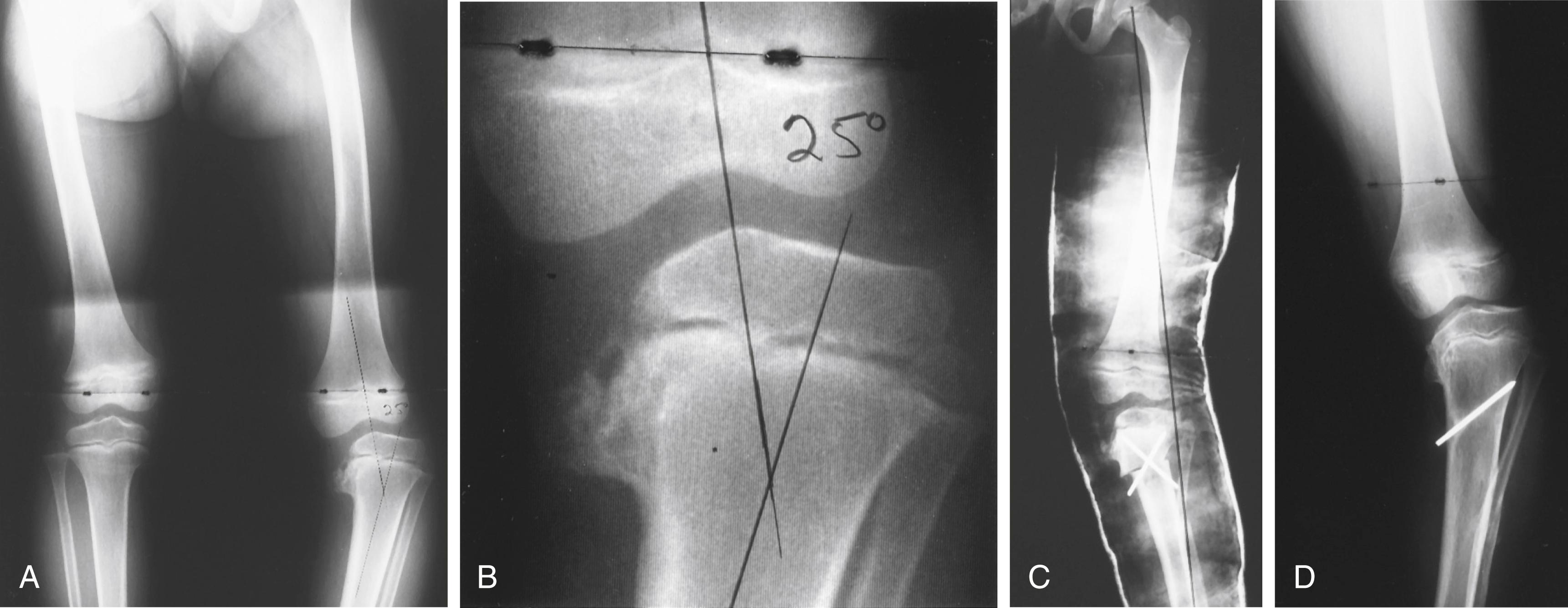
In non-Scandinavian patients, infantile tibia vara has a more challenging course with worse outcomes than originally reported. The reports from Scandinavian and Japanese centers continue to attest to a relatively benign course in more than 50% of their patients and to a condition that will spontaneously resolve, with the varus deformity correcting without treatment in up to three fourths of patients—an experience dramatically different from that in the United States and the Caribbean. , , ,
A new classification system has been proposed and tested at our institution. This scheme divided patients in to 3 types: type A has a partially lucent medial metaphyseal defect, with or without beaking; type B has a downward sloping curvature of the lateral and inferior rim of a completely lucent metaphyseal defect which then has an upslope at the medial rim and no epiphyseal downslope; and type C has a vertical downsloping deformity of both the epiphysis and metaphysis, and the epiphysis slopes downwards into the metaphysis. Initial evaluation shows age 5 to be the critical age, after which poor results and additional surgeries are more likely. Patients with type C lesions carry a poor prognosis that is rarely successfully managed with a single osteotomy ( Fig. 18.21 ).
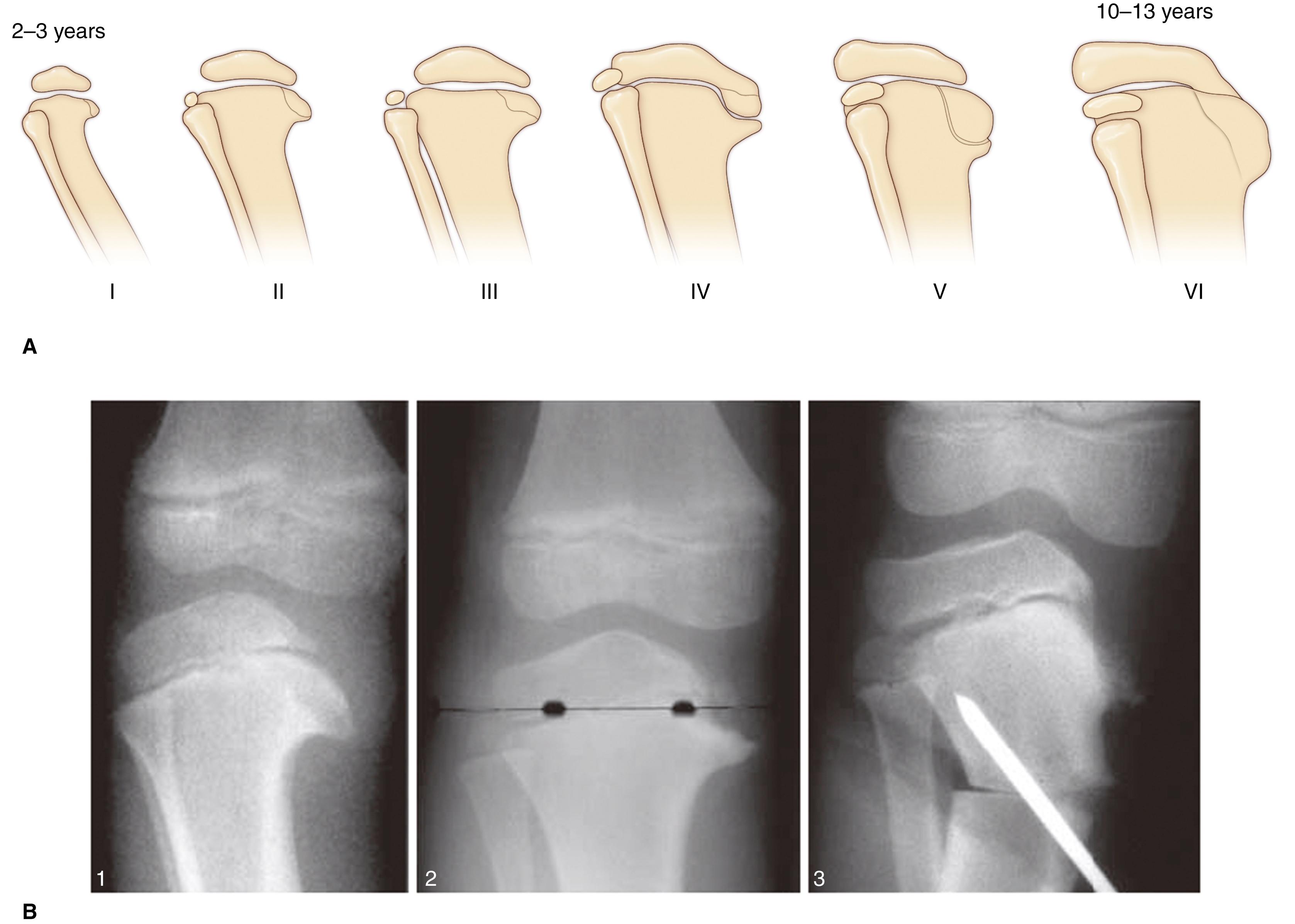
Untreated infantile tibia vara results in a nonresolving, progressive angular change, joint deformity, and growth retardation. Articular disruption of both compartments of the knee will often occur and cannot be corrected, regardless of treatment. Given the grim prognosis, once the diagnosis of infantile tibia vara is certain, treatment should quickly commence, as patients treated in the early stages of the disease have a chance for a better outcome. Observation of a known infantile tibia vara is an inappropriate treatment strategy.
Literature suggests that for children younger than 3 years old with early Langenskiöld stage I to II lesions, orthotic treatment may be successful in up to 50% of patients. The results are most encouraging in unilateral disease. , , , , When reviewing the orthotic literature, one must recognize that some braced patients likely had physiologic genu varum and an expected spontaneous resolution. This braced population may skew the results towards orthotic management appearing more successful. , , Nevertheless, orthotic treatment may play a role in the care of the youngest patients and braces appear to affect the natural history in many children. , ,
The ideal type of orthosis prescribed and prescription for wear is controversial. Raney and associates used a knee-ankle-foot orthosis (KAFO) that produced a valgus force by three-point pressure in 60 tibiae (38 patients), with lesions in 54 tibiae (90%) resolving without surgery. Significant risks for failure included ligamentous instability, patient weight greater than the 90th percentile, and late initiation of bracing. Of the 54 tibial lesions that resolved, 27 were treated by full-time orthotic use, 23 by nighttime use only, and 4 by daytime use. Three of the six tibiae requiring surgery had been treated with full-time orthotic use and three with nighttime use only. Based on these findings, the authors conjectured that nighttime-only bracing might be as efficacious as full-time bracing, although they acknowledged that one inherently would expect daytime use (i.e., during weight bearing) to be an important factor in successful orthotic treatment. Alternately, Zionts and Shean reported daytime ambulatory bracing to be successful in altering the natural history of tibia vara in patients younger than 3 years with Langenskiöld stage I or II disease.
We have used conventional KAFOs, conventional hip-knee-ankle-foot orthoses (HKAFOs), and elastic KAFOs in the treatment of infantile Blount disease. Since 1987, the elastic Blount brace, a medial upright design that uses a wide elastic band just distal to the knee joint ( Fig. 18.22 ), has been used almost exclusively because of its ease of fabrication and smaller profile. With this orthosis, 65% of tibiae had successful outcomes at an average follow-up of 5.9 years. However, corrective osteotomies for one or both extremities were eventually required in 70% of patients with bilateral involvement, as opposed to only 6% of patients with unilateral involvement. All patients were instructed to use the brace during the day (i.e., during weight bearing). Depending on the patient’s physician, some patients were encouraged to use the brace for 20 to 24 hours/day.
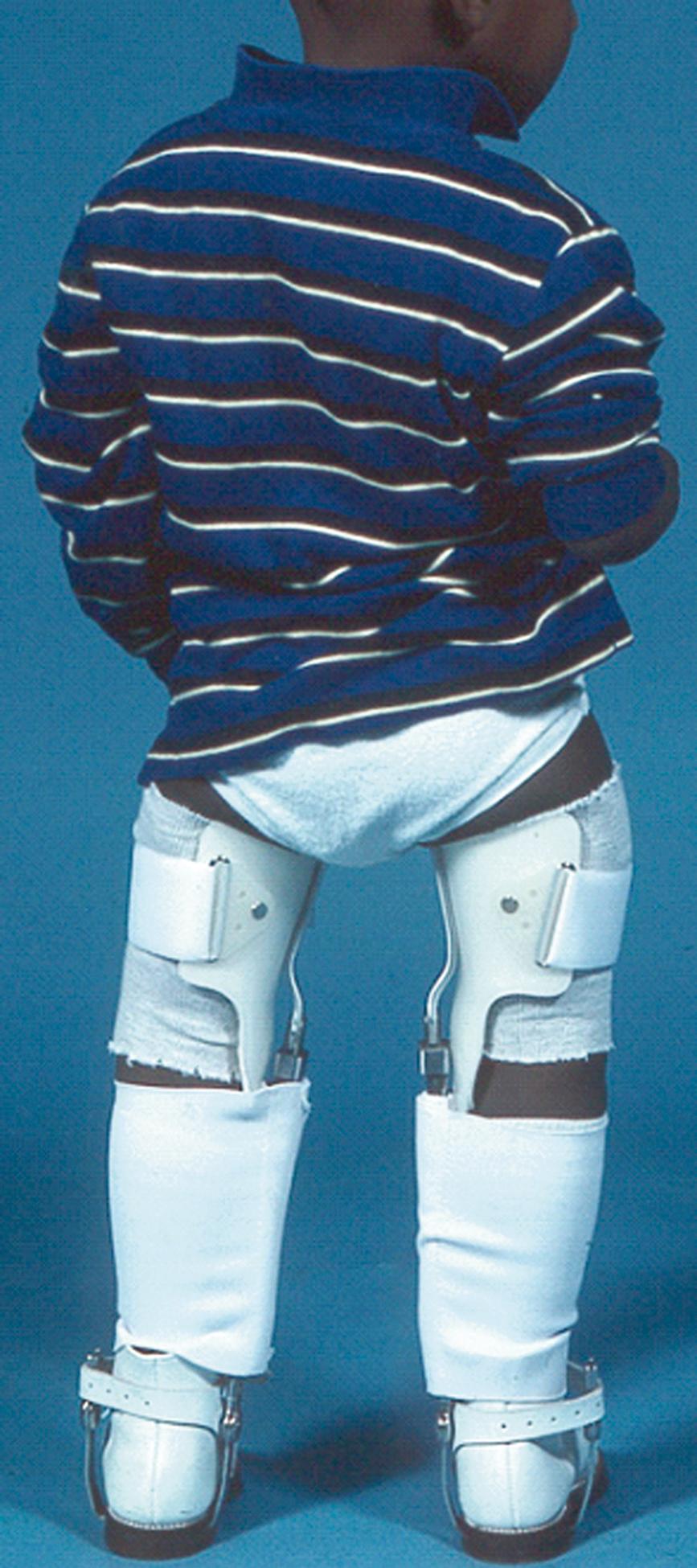
Early brace treatment appears to be effective in unilateral Langenskiöld stage I or II disease for patients under 36 months of age. Patients with bilateral involvement may benefit from orthotic management, but surgical correction is more likely to be needed for one or both extremities. Full-time orthotic treatment (i.e., 23 hours/day) is conventional to fully protect the knee exposed to varus forces during weight bearing and apply a valgus force at nighttime during non–weight bearing. ,
In this orthotic design, valgus correction is increased by bending the medial upright every few months until standing radiographs show a neutral, if not valgus, mechanical axis. Brace wear is then being gradually tapered over a period of several months. The metaphyseal lesion should improve radiographically while the mechanical axis is being corrected and the lesion should have nearly resolved when the patient is no longer using the orthosis.
Brace therapy is not appropriate for children older than 3 years. A maximum trial of 1 year of orthotic treatment to correct the varus deformity is recommended; thus if correction is not achieved within 12 months, a definitive osteotomy may still be performed before the patient is 4 years old. A good result from this single surgical intervention before age 4 years is expected in almost 90% of patients. A few months’ delay in performing surgery by 4 years old can result in failure to achieve permanent reversal of inhibition of the proximal medial physis. For stage III lesions and especially for stage IV lesions, it is debatable whether mechanical realignment with a single osteotomy can ever reverse the physeal inhibition (see Fig. 18.20 ). The association between those older than 5 years and biologic physeal arrest (stages IV and greater) cannot be overemphasized.
Surgical treatment in the early stages of the disease (stage I or II) is crucial to achieve permanent correction and to avoid the sequelae of joint incongruity, limb shortening, and persistent angulation. Patients with stage I or II disease have a significantly lower incidence of repeat osteotomy than do those with stage III disease. , , Surgical overcorrection of the mechanical axis to at least 5 degrees of valgus by 4 years of age and lateral translation of the distal osteotomy fragment is optimal. , , , , Overcorrection ensures that the supine correction attained at surgery will be sufficient to translate the mechanical axis into the lateral compartment of the knee once the patient begins bearing weight. Overcorrection of the mechanical axis offsets the tendency of the knee to go back into varus as a result of any sloping of the medial epiphyseal surface and relaxation of the lateral ligaments. Osteotomy to achieve absolute valgus alignment may reverse the excessive compressive forces medially and allow a Langenskiöld II or III physis, not already irreversibly damaged, to respond to such mechanical unloading.
The specific type of proximal tibial osteotomy (e.g., dome, closing wedge, or opening wedge) in young children is not important as long as the appropriate valgus and lateral translation are obtained. The level of osteotomy should be just distal to the patellar tendon insertion to avoid the proximal tibial physis and apophysis. The common internal tibial torsional deformity should be addressed by external rotation of the distal fragment. Fibular osteotomy should be performed routinely through a separate incision with care to avoid the peroneal nerve motor branches. Reliance on cast immobilization alone to maintain correction is not recommended as the cast is often split during the postoperative period. Internal fixation (e.g., with Kirschner wires) is helpful in maintaining correction. Prophylactic fasciotomy of the anterior, lateral, and posterior compartments is recommended because of the relatively high incidence of compartment syndrome. ,
Become a Clinical Tree membership for Full access and enjoy Unlimited articles
If you are a member. Log in here